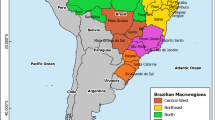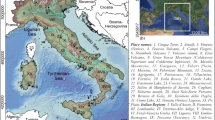Abstract
The term geodiversity is presented and critically examined. A summary of the concepts and definitions of this term is given, underlining the various approaches; in general, geodiversity is defined as a set of different “geological” elements over a certain area. A new approach is proposed, based on the identification of the “geological” elements, which mostly characterise the landscape features of a given territory, independently of their frequency and spatial distribution, but on the basis of type, scale and level of a new concept of geodiversity. With respect to Geomorphology, geodiversity may be defined with the term geomorphodiversity: “the critical and specific assessment of the geomorphological features of a territory, by comparing them in an extrinsic and in intrinsic way, taking into account the scale of investigation, the purpose of the research and the level of scientific quality”. The same concepts and methods can be experimented for other branches of the Earth Sciences; therefore, the same definition can be extended to the more general concept of diversity, by substituting the term “geomorphological” with the term “geological”. The peculiarities of the geomorphodiversity are shown, with particular reference to the Dolomites. First of all, they have specific geomorphological and landscape characteristics which distinguish them from all other mountains in the world, i.e. they have greatly accentuated extrinsic geomorphodiversity on a global scale. On a regional scale and in relation to morphostructural landforms, the Dolomites have a high degree of extrinsic geomorphodiversity compared with other alpine mountains in relation to morphotectodynamics, morphotectostatics and morpholithology. They also have greatly accentuated intrinsic geomorphodiversity on a regional scale from the morphoclimatic viewpoint, considering their polygenesis linked to pre- or inter-glacial, glacial, periglacial, fluvial, relict, dormant or active landforms. Nevertheless, when some geomorphological features, chosen with a subjective criterion, are examined in detail on a regional scale (for example talus cones or scree slopes), they show a limited intrinsic geomorphodiversity; whereas in other cases (as for landslides) they have a great intrinsic geomorphodiversity. Another example is offered by karst areas; they display in detail a vast array of landforms, that is considerable intrinsic geomorphodiversity on a local scale. In conclusion, the Dolomites make up an important geoheritage that can be considered as a high-altitude field laboratory for research and development of geomorphological theories and understanding.










Similar content being viewed by others
References
Barthlott W, Lauer W, Placke A (1996) Global distribution of species diversity in vascular plants: towards a world map of phytodiversity. Erdkunde 50(4):317–327
Bosellini (1996) Geologia delle Dolomiti. Athesia, Bolzano, p 192
Bruschi VM (2007) Desarrollo de una metodologìa para la caracterizaciòn, evaluaciòn y gestiòn de los recursos de la geodiversidad. Tesis doctoral, Universidad de Cantabria, Santander, Dep. Ciencias Tierra y Fis. Mat. Cond., 354 pp
Carcavilla Urqui L (2006) Patrimonio geologico y geodivesidad: investigaciòn, conservaciòn, gestiòn y relaciòn con los espacios naturales protegidos. Tesis doctoral, Universidad Autonoma de Madrid, Dep. Quim. Agr Geol Geoq, 339 pp
Carton A, Pelfini M (1988) Forme del paesaggio d'alta montagna. Scuola di montagna, 5. Zanichelli, Bologna, 136 pp
Carton A, Soldati M (1993) Geomorphological features of the Dolomites (Italy). In: Panizza M, Soldati M, Barani D (eds) First Europ. Intens. Course on Appl. Geomorph.—Proceed., Univers. Modena, pp 13–29
Castiglioni GB (1964) Sul morenico stadiale delle Dolomiti. Mem. Ist. Geol. e Min. Univ. di Padova, 24, 16 pp
Corsini A, Panizza M (2003) Conseguenze geomorfologiche di una faglia neotettonica nell’Alta Val Badìa (Dolomiti). In: Biancotti M (ed) Risposta dei processi geomorfologici alle variazioni ambientali. MURST-COFIN, Brigati, Genova, pp 173–176
Cox L (2003) Staffordshire geodiversity action plan. Stafford Wildlife, 59 pp
Cruden DM, Varnes DJ (1996) Landslides Types and Processes. In: Turner, S (ed) Landslides: Investigation and Mitigation, Transportation Research Board, National Academy of Sciences, Washington D.C., Special Report 247, 36–75
D’Andrea M, Lisi A, Mezzetti T (eds) (2005) Patrimonio geologico e Geodiversità. APAT, Roma, Rapp. 51, 240 pp
Dixon G (1996) Geoconservation: an international review and strategy in Tasmania. Misc. Rep. Parks & Wildlife Serv, Tasmania, p 101
Eberhard R (ed) (1997) Pattern and process: towards a regional approach to national estate assessment of geodiversity. Technical Series No. 2, Australian Heritage. Commission & Environment Forest Taskforce, Environment Australia, Canberra, 102 pp
Erikstad L (1999) A holistic approach to secure geoconservation in local physical planning. In: Barettino D, Vallejo M, Gallego E (eds) Towards the balanced management and conservation of the Geological Heritage in the New Millenium. Sociedad Geológica de España, Madrid, pp 69–72
Fazzini M, Panizza M (2006) I crolli nelle Dolomiti orientali nell'estate 2004. In: Salgaro S. (ed) Scritti in onore di R. Bernardi, Patron, Bologna, pp 247–257
Gerasimov IP (1946) Experience with geomorphological interpretation of the general scheme of geological structure of URSS. Probl Fizich Geogr 12:89–115
Gianolla P (2008) Geology. In: Nomination of the Dolomites for inscription on the World Natural Heritage List UNESCO; Dolomiti, Belluno, 1, 363 pp
Gray M (2004) Geodiversity valuing and conserving abiotic nature. Wiley, Chichester, p 434
Gruber S, Hoelzle M, Haeberli W (2004) Permafrost thaw and destabilization of Alpine rock walls in the hot summer of 2003. Geophys Res Lett 31(L13504):1–4. doi:10.1029/2004GL020051
Micheletti C (2008) Landscape and aesthetics. In: Nomination of the Dolomites for inscription on the World Natural Heritage List UNESCO; Dolomiti, Belluno, 1, 363 pp
Nieto LM (2001) Geodiversidad: propuesta de una definicion integradora. Bol Geol Min 112(2):3–12
Panizza M (1973) Glacio pressure implications in the production of landslides in the Dolomitic area. Geol Appl Idrogeol 8(1):289–297
Panizza M (1988) Geomorfologia. In: Panizza M (ed) Guide naturalistiche delle Dolomiti venete, vol. 1, Dolomiti, S. Vito di Cadore, 43–54
Panizza M (1990) Il fascino e le vicende della storia geomorfologica delle Dolomiti. In: Comunità Montana Agordina, Le Dolomiti un patrimonio da tutelare e amministrare, 19–31
Panizza M (2008) Geomorphology. In: Nomination of the Dolomites for inscription on the World Natural Heritage List UNESCO; Dolomiti, Belluno, 1, 363 pp
Panizza M (2009) Geomorphodiversity of the Dolomites and some remarks on recent rock falls. In: Malet J-P, Remaitre A, Bogaard T (eds) Landslides processes, from geomorphological mapping to dynamic modelling. CERG Editions, Strasbourg, p 356
Panizza M, Dibona D (1990) Segnalazione di un suolo presso il Col Bechei (Dolomiti di Fanes) e suo possibile significato neotettonico. Quaternario 3:31–38
Panizza M, Piacente S (2008) La geodiversita’ e una sua applicazione nel territorio emiliano. Il Geologo dell’Emilia-Romagna 8(29):35–37
Panizza M, Piacente S (2009) Cultural geomorphology and geodiversity. In: Reynard E, Regolini-Bissig G, Coratza P (eds) Geomorphosites: assessment, mapping and management. München, Pfeil (in press)
Panizza M, Carton A, Castaldini D, Mantovani F, Spina R (1978) Esempi di morfoneotettonica nelle Dolomiti occidentali e nell'Appennino modenese. Geogr Fisica Dinamica Quaternaria 1:28–54
Piacente S (2005) Geosites and geodiversity for a cultural approach to geology. In: Piacente S, Coratza P (eds) Geomorphological sites and geodiversity. Il Quaternario, 18 (1), vol. spec., 11–14
Piacente S, Coratza P (eds) (2005) Geomorphological sites and geodiversity. Il Quaternario 18 (1), vol. sp., 332 pp
Pralong GP (2006) Géotourisme et utilisation de sites naturels d'intérêt pour les sciences de la Terre. Thèse de doctorat, Université de Lausanne, 241 pp
Reynard E, Coratza P (2007) Geomorphosites and geodiversity: a new domain of research. Geogr Helv 62:138–139
Serrano E, Ruiz-Flaño P (2007) Geodiversity. A theoretical and applied concept. Geogr Helv 62:140–147
Sharples C (1995) Geoconservation in forest management-principles and procedures. Tastforest Hobart 7:37–50
Soldati M, Corsini A, Pasuto A (2004) Landslides and climate change in the Italian Dolomites since the Lateglacial. Catena 55(2):141–161. doi:10.1016/S0341-8162(03) 00113-9
Tricart J (1965) Principes et méthodes de la Géomorphologie. Masson, Paris, p 496
Zwolinski Z (2004) Geodiversity. In: Goudie AS (ed) Encyclopaedia of geomorphology, vol 1. Routledge, London, pp 417–418
Author information
Authors and Affiliations
Corresponding author
Rights and permissions
About this article
Cite this article
Panizza, M. The Geomorphodiversity of the Dolomites (Italy): A Key of Geoheritage Assessment. Geoheritage 1, 33–42 (2009). https://doi.org/10.1007/s12371-009-0003-z
Received:
Revised:
Accepted:
Published:
Issue Date:
DOI: https://doi.org/10.1007/s12371-009-0003-z




